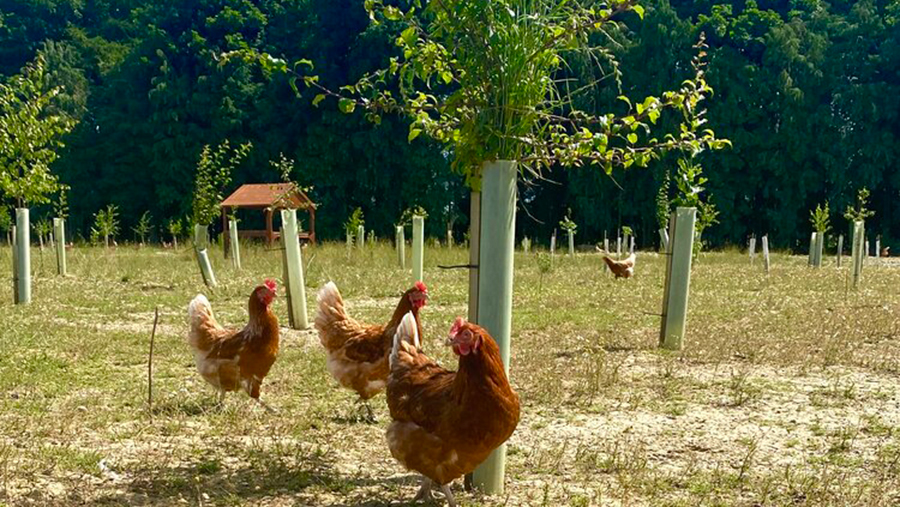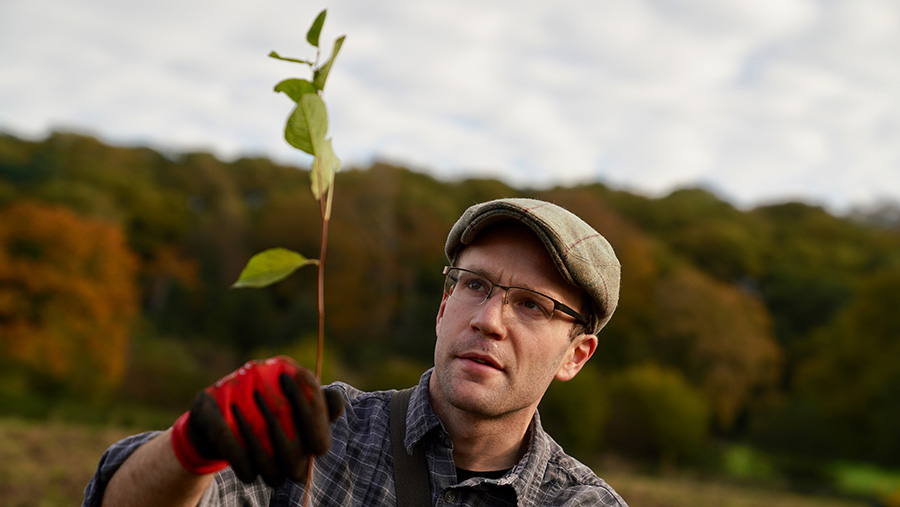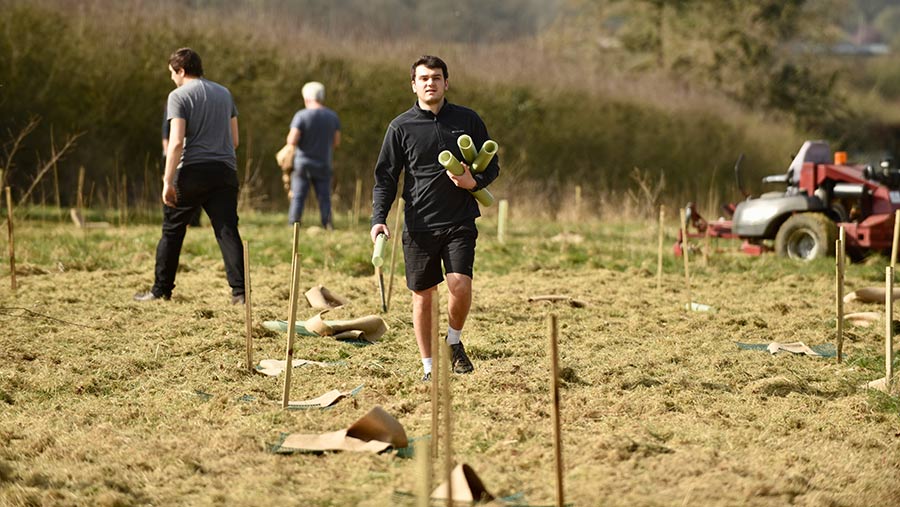Advertiser content
Embrace innovation on your farm with funded tree planting
Trees and woodland can become a valuable farm asset
New ideas are the lifeblood of successful farm businesses; they drive a competitive edge, help you stand out against your peers, and can cut costs too.
Doing things differently can deliver a real dividend and if those new ideas also come with funding, support and expert advice attached, then saying ‘yes’ to innovation is as solid a business decision as investing in technology or getting someone really good to manage the books.
For the team at poultry business Sally Farm in North Yorkshire, innovation has been helping them grow and flourish as a business for the last five years, and the planting of trees has been a consistent part of their strategy.
Sally Farm is currently working with the White Rose Forest, one of England’s Community Forests, on planting 30-40 acres of new woodland this season, through a funded programme called Trees for Climate.
It’s the latest phase in a five year programme that has seen trees and woodland become a central theme in this flourishing business.
“The ethos here is to have a poultry farm in a nature reserve,” says Steve, the general manager. “It’s not easy to get there, and you have to weigh up land values, income levels, and profits, but there are so many benefits for us.”
This 596 acre farm was largely arable until the new owner put up a poultry shed and made high welfare, sustainable egg production the mainstay of the business.
To hit the requirements of the egg standard they’re working to (and RSPCA targets too) they need to put in at least five acres of trees for every 16,000 birds; across the 80 acres of ranges they’ve created for their chickens, trees have become a valuable asset.

Sally Farm, North Yorkshire is planting 30-40 acres of new woodland this season, through a funded programme called Trees for Climate © Sally Farm
Poultry problems? They’re planting opportunities
About 20,000 trees have been planted so far across Sally Farm, they’ve restored hedgerows, created a tree-lined drive into the farm, established their own tree nursery on site, but they’ve been innovating with trees too.
Even though their farming methods mean there’s a reduced problem with pollution, planting trees can mitigate any problems even further.
“We can use trees to catch ammonia” says Steve. “Poultry can produce quite a lot and it’s no use to anybody, a problem in fact. What we’ve been doing in the last year or so is to plant some fast-growing species to try and catch the ammonia dust.
Then the trees will use the nitrates within that ammonia to help them grow – a self-fuelling cycle.”
One of the key purposes of planting with White Rose Forest was to assist flood prevention across the catchment all the way through to York, and so water is a vital factor in the plan, too.
In addition to capturing food to support the trees as they grow, the planting helps to avoid agricultural runoff into local water courses, which also gives them a win on water quality.
Another innovation they’ve been working on is planting willow tunnels and walkways away from the birds’ sheds and out into the ranges, to encourage birds to venture out and put the ‘free’ into free range.
“We want to keep the tree thing going,” says Steve. “For the poultry ranges in particular it makes total sense. The land we are planting trees on with the White Rose Forest is waterlogged and cannot be used for farming, it is effectively land we can’t use.”
Working with the White Rose Forest
Sally Farm had approached a range of sources of support for more tree planting, and eventually found the White Rose Forest online, approached them, and their team picked it up quickly and got to work. “We spent a good half day walking the farm,” says Steve.
“Looking at the woodlands we’ve already got established, like some lovely troves of oak. Then we pulled the land areas together that we could work with to around 40 acres that we are planting this season.”
The scheme planned for this year will be particularly focused on helping the Swale catchment management plan, and reducing farm run off.
The White Rose Forest has been able to support with planning, advice, funding and delivery through Trees for Climate; a national programme, funded by Defra’s Nature for Climate Fund.
Established in November 2020, the multimillion pound programme works across the network of 13 Community Forests in England and in the 2021/22 planting season alone achieved some significant outcomes:
- 606 hectares of trees planted, working with a range of landowners
- Responsible for 27% of all new tree planting in England during that season
- 66 schemes planted in the top 10% most deprived areas nationally
There are a range of activities on farm that the fund can support including:
- Multi-use woodland at a larger scale of more than five hectares
- Low density tree planting
- Small scale tree planting of less than five hectares
- Natural colonisation
- Hedgerow planting and restoration
For Sally Farm the Trees for Climate scheme is good for nature, helps them celebrate being low carbon, and has brand benefits with suppliers and with the local community, all of which means that there’s little surprise they’re keen to do more in future planting seasons.

A farm in west Cheshire where over 7 hectares of woodland were created with Mersey Forest and Forward Agricultural Services Ltd © The Mersey Forest
Innovation by design
Matt Taylor is an independent forestry consultant in West Yorkshire who works with land managers, farmers and large estates to develop forestry schemes that can be funded, work with their business plans and that also embrace innovation.
With one current scheme he’s pushing the boundaries and showing what true, multi-purpose forestry should look like.
“I’m just in the process of getting this scheme approved,” he said. “And I think it’s a fair example of what all schemes should look like, full of multiple benefits and multiple approaches to what you can do with woodland.”
The farm-based 125 hectare scheme has design features that include:
- 25 hectares of continuous cover forestry to deliver a red squirrel reserve
- Riparian planting (riverside) to deliver higher levels of water quality
- 20 hectares of wood pasture for grazing livestock
- Community orchards to benefit the local community
- A Scots pine plantation inoculated with Lactarius to produce edible fungi
According to Matt, the new areas of food production will be delivering as early as year three, and the overall strategy is to plant trees but overall to see levels of food production go up, and not down, as a result.
“What we’ve done is we’ve taken 125 hectares that was single function,” he says,”and we’re moving that to something that is genuinely multi-functional.
It’s still going to have food production, but there’ll also be carbon sequestration, biodiversity, water quality benefits and public access across the site.”
Get planting, get the benefits
For Matt, even though stewardship and support schemes continue to change around plans for greater environmental land management, for anyone who has the opportunity, developing a woodland creation scheme through Trees for Climate with the help of England’s Community Forests is a safe and winning bet.
“My advice if you’re interested in more trees is to do it now,” says Matt. His experience of working with a number of farmers and landowners is that the offer from the Community Forests is flexible, collaborative, easy to follow, and has the ability to make farmers money.
“What the Community Forests can offer is at least the same level of financial support as other schemes, but with more flexibility and a hands-on, personal approach,” he says.
For Matt, the schemes that work best for farmers are genuine agroforestry projects that integrate with farm systems and offer a clear and proven return for the investment.
He says that the outdated model of forestry that many people think of – 700 hectares of Sitka Spruce on a hillside in Scotland – is not what works today and that productive, profitable, planting plans, working alongside the business plan of a farm, is what the clients he works with should be aiming for.

A farm near Northwich, Cheshire where 440 trees were planted to create an amenity woodland. © The Mersey Forest
Plan, plant and profit
Combining a farm operation with tree planting and hedgerow restoration is sometimes labelled as ‘agroforestry’ and whether you are an upland sheep farmer, lowland dairy or largely arable, there are strong benefits to be secured through working with a local Community Forest, or with other woodland advisors, to get a tree planting scheme into the ground.
England’s Community Forests, through the Trees for Climate fund, offer one of the most competitive grant schemes for tree planting. Partnering with your local Community Forest makes sense for a host of reasons:
- They have years of experience and locally based support and knowledge to help you plan, fund and deliver woodland creation projects of all sizes
- You’ll get an expert advisor, delivery partner and funder in one, local organisation
- They keep it simple – minimum fuss and paperwork
- As well as grants that cover up to 100% of costs, you get 15 years of maintenance payments, to ensure that any planting continues to deliver long term value for you
The next step is literally just a couple of clicks away, head over to the website for England’s Community Forests and get in touch with a partner close to you.
Further information
If your land is not in one of our 13 Community Forests you can still access grants from other Woodland Creation Partners or the Forestry Commission. For more information visit: woodlandcreation.campaign.gov.uk/
Provided by
England’s Community Forests are experts in woodland creation. We offer free advice, grants and support to plant trees and create new woodland on your land; from planning to delivery and long-term management.
www.englandscommunityforests.org.uk